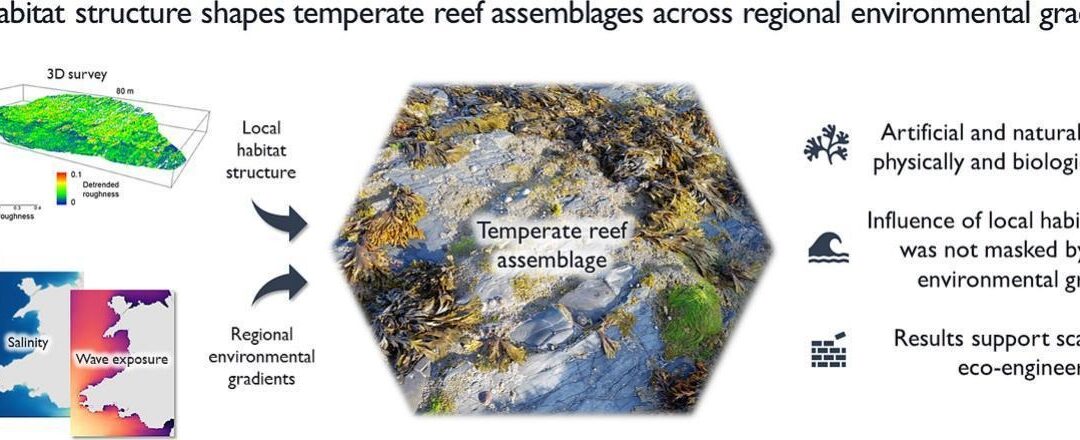Habitat structure shapes temperate reef assemblages across regional environmental gradients
Jackson-Bué T, Evans AJ, Lawrence PJ, Brooks PR, Ward SL, Jenkins SR, Moore PJ, Crowe TP, Neill SP, Davies AJ
Intertidal artificial habitats are proliferating, but are generally simpler in structure and host lower biodiversity than natural rocky reefs. Eco-engineering aims to enhance the biodiversity of coastal infrastructure, often through physical structural modifications that mimic topographic properties of natural shores. Relationships between biotic assemblages and structural properties of natural and artificial reefs have been extensively studied at sampling scales of up to 1 m2. But evidence that quantified local structural variation has an appreciable influence on biotic assemblages, at a shore-wide scale across regional environmental gradients, is lacking. Here we addressed this knowledge gap with an observational study at 32 natural and artificial intertidal reef sites in Wales, UK. We used multivariate community analysis and permutation tests to examine associations between local physical structure, regional environmental variables and sessile biotic assemblages. A potential influence of local habitat structure on assemblage composition was evident across regional-scale environmental gradients. Compared to natural sites, artificial reefs had lower taxonomic richness, distinct and more variable assemblage composition, and different physical structure. After removing the effect of habitat (natural or artificial), canonical correspondence analysis showed that environmental variables (wave exposure, sea surface temperature and salinity variation), along with two metrics of physical structure (standard deviation in log-transformed detrended roughness and skewness of surface verticality, both at 0.5 m scale), explained 40 % of the variation in assemblage composition among sites. The two structural metrics independently explained 14.5 % of the variation. Associations identified between individual taxa and environmental variables indicated that sites with a higher proportion of horizontal surfaces hosted more canopy macroalgae, which in turn support other algae and invertebrates. Our findings provide evidence to inform scaling-up of structural eco-engineering interventions from experimental contexts to enhance the biodiversity of coastal infrastructure across regional extents.
Request PDF
| To request a PDF copy of this paper, please enter your email address below: Your email address is not stored, it is only used to send an email with an attached PDF to you. |
Full Citation
Jackson-Bué T, Evans AJ, Lawrence PJ, Brooks PR, Ward SL, Jenkins SR, Moore PJ, Crowe TP, Neill SP, Davies AJ (2024) Habitat structure shapes temperate reef assemblages across regional environmental gradients. Science of The Total Environment 906: 167494

